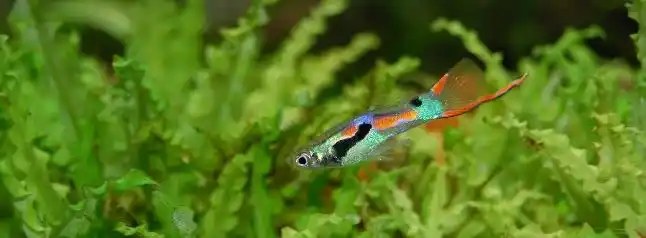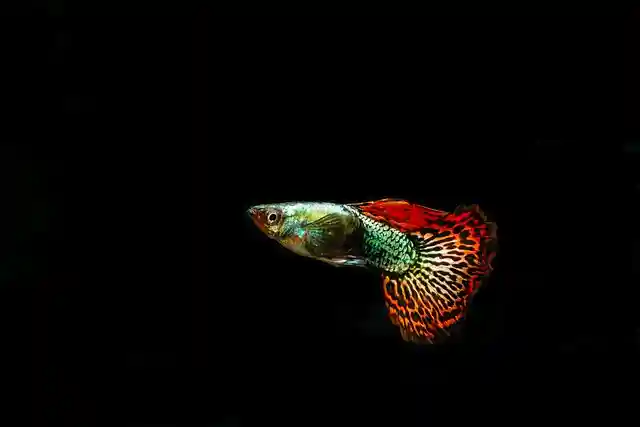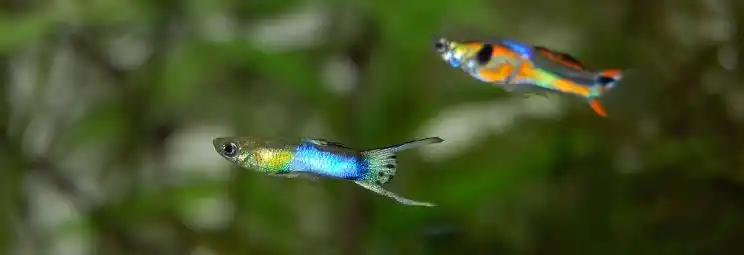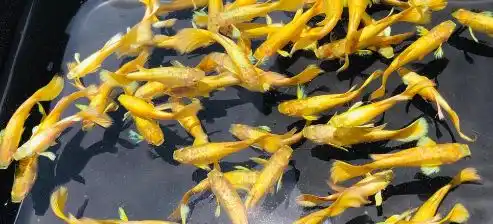Fish Guppies, scientifically known as Poecilia reticulata, are small freshwater fish native to South America. They are highly popular among aquarium enthusiasts due to their vibrant colors, ease of care, and fascinating behavior. In this article, we will explore the world of guppies, their characteristics, care requirements, breeding habits, and the benefits of keeping them in your aquarium.
The Origin and Natural Habitat of Fish Guppies

Guppies are native to the freshwaters of South America, specifically Venezuela, Trinidad, and parts of Brazil. They inhabit streams, rivers, and stagnant bodies of water, where they can be found in both dense vegetation and open areas. These small fish have successfully adapted to various environmental conditions, which has contributed to their widespread popularity among aquarium hobbyists.
Appearance and Color Varieties of Fish Guppies

Fish Guppies are known for their remarkable colors and unique patterns. The males, in particular, exhibit a stunning array of hues, ranging from vibrant reds, blues, and greens to metallic shades and even iridescent colors. Female guppies, while less flashy, possess their own beauty with a variety of muted colors and intricate patterns. The wide range of color variations has led to the development of numerous guppy strains, each with its distinct characteristics.
Overview of Fish Guppy Characteristics
| Characteristic | Description |
|---|---|
| Scientific Name | Poecilia reticulata |
| Common Name | Guppy |
| Size | Typically 1.5 to 2.5 inches (3.8 to 6.3 cm) in length |
| Lifespan | 2 to 3 years, but can live longer with proper care |
| Habitat | Freshwater, often found in tropical and subtropical |
| Color Variations | Vibrant colors, including red, blue, yellow, and more |
| Body Shape | Small, slender, and laterally compressed |
| Sexual Dimorphism | Males are usually more colorful than females |
| Reproduction | Livebearers; females give birth to live fry |
| Diet | Omnivorous, eating both plant matter and small |
| invertebrates | |
| Behavior | Active and social, often seen swimming in groups |
| Temperature Range | 72-82°F (22-28°C) |
| pH Range | 6.8-7.8 |
| Tank Size | 10 gallons or larger for a small community |
Setting Up the Ideal Aquarium for Fish Guppies
To provide a suitable environment for guppies, it is essential to set up the right aquarium. A tank with a capacity of at least 10 gallons is recommended for a small community of guppies. The tank should be equipped with a heater to maintain a stable temperature, a filtration system to keep the water clean, and adequate lighting. Additionally, it is important to provide hiding spots and plants to mimic their natural habitat and create a stress-free environment.
Fish Guppies Water Conditions and Temperature Requirements
Guppies thrive in freshwater with a pH level between 6.8 and 7.8. The water temperature should ideally be maintained between 74°F and 82°F (23°C to 28°C) to ensure the well-being of these tropical fish. Regular monitoring of water parameters, including ammonia, nitrite, and nitrate levels, is necessary to maintain a healthy and stable aquatic environment.
Feeding and Nutrition for Fish Guppies
Guppies are omnivorous, meaning they eat a variety of foods. A balanced diet for guppies includes a combination of high-quality flake or pellet food specifically formulated for tropical fish, as well as occasional live or frozen foods such as brine shrimp or daphnia. It is important to provide them with small, frequent meals to prevent overfeeding and maintain their overall health.
Fish Guppies Social Behavior and Compatibility
Guppies are generally peaceful and social fish, making them excellent additions to community aquariums. They get along well with other peaceful species like tetras, mollies, and swordtails. However, it’s important to avoid aggressive or fin-nipping fish that may harm their delicate fins. Keeping guppies in groups of six or more will help them feel secure and reduce stress.
Fish Guppies Breeding Process

Fish guppies are fascinating because of their breeding behavior. They are livebearers, meaning they give birth to baby fish (called fry) instead of laying eggs. Male guppies show off their bright colors and fancy fins to attract females. Once fertilized, a female guppy can give birth to multiple batches of fry from a single mating, making them excellent breeders.
Steps for Breeding Fish Guppies
Select Healthy Parents
Select guppies that are robust, disease-free, and exhibit desirable traits such as vibrant colors.
Provide Space & Good Conditions
Use a breeding tank with enough room.
Watch the courtship behavior between males and females.
Add Hiding Places
Use plants or artificial shelters so fry can hide.
This prevents adult guppies from eating them.
Monitor Pregnancy
Female guppies are pregnant for about 4–6 weeks.
Look for signs like a swollen belly or dark gravid spot.
Separate Fry After Birth
Move the mother back to the main tank after giving birth.
Place fry in a nursery tank with gentle filtration.
Feed Fry Properly
Give them small, nutritious foods like crushed flakes or baby brine shrimp.
Maintain Water Quality
Check water parameters regularly.
Do partial water changes to keep conditions healthy.
Keep Records
Note breeding pairs, birth dates, and traits you want to track.
Cull When Needed
Remove fry that don’t meet your breeding goals.
This helps improve future generations.
Common Diseases and Health Issues
Like any aquarium fish, guppies are susceptible to certain diseases and health issues. The most common ailments include fungal infections, parasites, and bacterial diseases. Regular observation, maintaining clean water conditions, and providing a balanced diet can significantly reduce the risk of diseases. Quarantining new fish before introducing them to the main tank is also recommended to prevent the spread of potential infections.
Here are some common diseases and health problems that can affect guppies:
- Ich (White Spot Disease):
- One of the most common fish diseases.
- Symptoms include white cysts or spots on the skin, clamped fins, and rubbing against objects.
- Caused by a parasite (Ichthyophthirius multifiliis).
- Fin Rot:
- Bacterial infection that leads to the deterioration of fins.
- Symptoms include frayed or rotting fins, lethargy, and loss of appetite.
- Dropsy:
- A condition where the fish’s abdomen swells due to fluid retention.
- Symptoms include bloating, scales standing on end (pineconing), and loss of appetite.
- Dropsy can be caused by various factors, including bacterial infections.
- Velvet Disease (Oodinium):
- Caused by a parasitic protozoan.
- Symptoms include a fine, gold or rust-colored dusting on the skin, rapid gill movement, and lethargy.
- Columnaris (Cotton Wool Disease):
- Bacterial infection that appears as white, cotton-like growth on the skin, fins, or mouth.
- Fish may become lethargic, lose appetite, and show discolored patches.
- Gill Flukes and Skin Flukes:
- Parasitic flatworms that affect gills and skin.
- Symptoms include labored breathing, excessive mucus production, and scratching against objects.
- Constipation:
- Guppies can suffer from constipation if fed a diet that is too high in protein or low in fiber.
- Symptoms include bloating, inactivity, and difficulty passing feces.
- Swim Bladder Disorder:
- Fish may have trouble controlling their buoyancy, leading to swimming issues.
- Can be caused by overfeeding, bacterial infection, or physical trauma.
- Parasitic Infections:
- Various internal and external parasites can infect guppies, causing symptoms like weight loss, changes in behavior, and visible parasites on the body or in the feces.
- Stress-Related Issues:
- Guppies can experience stress due to poor water quality, overcrowding, sudden changes in temperature, or aggressive tankmates.
- Stress weakens the immune system and makes fish more susceptible to diseases.
Tips for Maintaining a Healthy Guppy Population
To maintain a healthy guppy population, it is crucial to practice proper aquarium maintenance. Regular water changes, testing water parameters, and cleaning the tank and filters are essential tasks. Providing a varied and nutritious diet, avoiding overstocking, and monitoring any signs of illness or stress are vital for the well-being of your guppies.
Here are some tips to help you keep your guppies in good health and ensure a thriving population:
- Provide Proper Tank Conditions:
- Maintain stable water parameters, including temperature (72-82°F or 22-28°C), pH (6.8-7.8), and water hardness.
- Ensure good water quality by performing regular water changes (about 20-30% every 1-2 weeks) and using a reliable filtration system.
- Adequate Tank Size:
- Avoid overcrowding by providing enough space for your guppies to swim and thrive. A general guideline is about 1 gallon (3.8 liters) per guppy.
- Variety in Diet:
- Offer a balanced diet that includes high-quality flake or pellet food, supplemented with live or frozen foods like brine shrimp, daphnia, and bloodworms.
- Avoid overfeeding, as it can lead to obesity and health problems.
- Quarantine New Additions:
- Always quarantine new fish for a couple of weeks in a separate tank before introducing them to your main tank. This helps prevent the spread of diseases.
- Regular Observation:
- Spend time observing your guppies daily. Look for any signs of illness, changes in behavior, or aggression among tankmates.
- Maintain Hiding Places:
- Provide plants or decorations that offer hiding spots for guppies, especially for pregnant females and fry, to reduce stress and protect them from potential aggressors.
- Breeding Management:
- If you’re breeding guppies, ensure proper care for fry by providing a separate nursery tank and appropriate food.
- Separate unhealthy or deformed fry to improve the overall quality of your breeding stock.
- Control Tank Temperature:
- Keep the tank temperature within the recommended range, as extremes can stress guppies and make them more susceptible to disease.
- Minimize Stressors:
- Reduce sudden changes in water conditions, aggressive tankmates, and unnecessary disturbances to minimize stress.
- Regular Water Testing:
- Use water test kits to monitor parameters like ammonia, nitrite, nitrate, and pH. Address any issues promptly.
- Treat Diseases Promptly:
- If you notice signs of illness, quarantine the affected fish and treat them with appropriate medications. Follow the instructions carefully.
- Selective Breeding:
- If you’re interested in specific color patterns or traits, consider selective breeding while maintaining the overall health of your guppy population.
- Research and Learn:
- Continuously educate yourself about guppy care and common diseases. Join aquarium forums or clubs to exchange information and experiences with other hobbyists.
Adding Fish Guppies to Your Aquarium: Tips for Beginners

For beginners, guppies are an excellent choice of fish due to their hardiness and ease of care. When introducing new guppies to your aquarium, it is recommended to acclimate them slowly to prevent any sudden changes in water parameters. Adding a few guppies at a time allows the tank to adjust gradually and minimizes stress for both the new and existing fish.
Guppies as Educational Tools
Guppies can be valuable educational tools, especially in school settings. Their vibrant colors and diverse patterns offer opportunities for students to learn about genetics, selective breeding, and natural selection. Breeding and observing guppies can provide hands-on experience and spark curiosity in young minds.
The Benefits of Keeping Fish Guppies
Keeping guppies as pets offers several benefits. They are relatively low-maintenance, making them suitable for both experienced and novice aquarists. Their striking colors and graceful swimming patterns add visual appeal to any aquarium. Additionally, observing their social interactions and breeding behavior can be an enjoyable and rewarding experience.
Environmental Impact and Conservation Efforts
While guppies are widely available in the aquarium trade, it is important to consider their impact on the environment. In some cases, guppies introduced to non-native habitats have become invasive species, outcompeting native fish populations. Responsible ownership and proper disposal of unwanted guppies can help minimize their environmental impact. Furthermore, conservation efforts focus on preserving the natural habitats of guppies and protecting their genetic diversity.
Types of Fish Guppies

Beyond the familiar common guppy, there are numerous guppy varieties worth exploring. These include fancy guppies with elaborate fin shapes, tail types, and color patterns, as well as rare or exotic strains that require specialized care. Each guppy variety offers its own unique charm and can provide aquarists with endless possibilities for customization and personalization. Here are some common types of guppies:
- Tuxedo Guppies
- Cobra Guppies
- Metallic Guppies
- Veil Tail Guppies
- Half-Moon Guppies
- Delta Tail Guppies
- Round Tail Guppies
- Swordtail Guppies
- Fan Tail Guppies
- Lyretail Guppies
- Flagtail Guppies
- Moscow Guppies
- Mosaic Guppies
- Snakeskin Guppies
- Golden Guppies
Conclusion
Fish Guppies are an interesting and charming fish species that will capture your hearts. With their vibrant colors, ease of care, and engaging behavior, guppies make an excellent choice for both beginner and experienced fish keepers. By understanding their habitat, meeting their specific care requirements, and appreciating their unique qualities, you can create a thriving and visually stunning guppy aquarium.
Frequently Asked Questions (FAQs)
-
Are fish guppies suitable for beginners?
Yes, guppy fishes are highly recommended for beginners due to their hardiness and ease of care. They are a great way to start your aquarium journey.
-
How many fish guppies can I keep in my tank?
It is best to keep guppies in groups of six or more to ensure their well-being and minimize stress. The tank size will determine the maximum number you can keep.
-
Can guppies live with other fish?
Guppy fish are generally peaceful and can live harmoniously with other peaceful species like tetras, mollies, and swordtails. Avoid aggressive or fin-nipping fish.
-
Do fish guppies require a heater in their tank?
Yes, guppies are tropical fish and require a stable water temperature between 74°F and 82°F (23°C to 28°C). A heater is necessary to maintain the optimal temperature.
-
How often should I feed my fish guppies?
It is recommended to feed your guppies small, frequent meals multiple times a day. Monitor their feeding behavior and adjust the amount accordingly.
Sources and References
Food and Feeding Habits of the Guppy, Poecilia reticulata – A Study by Lawal, M. O., Edokpayi, C. A., and Osibona, A. O. (2012)




